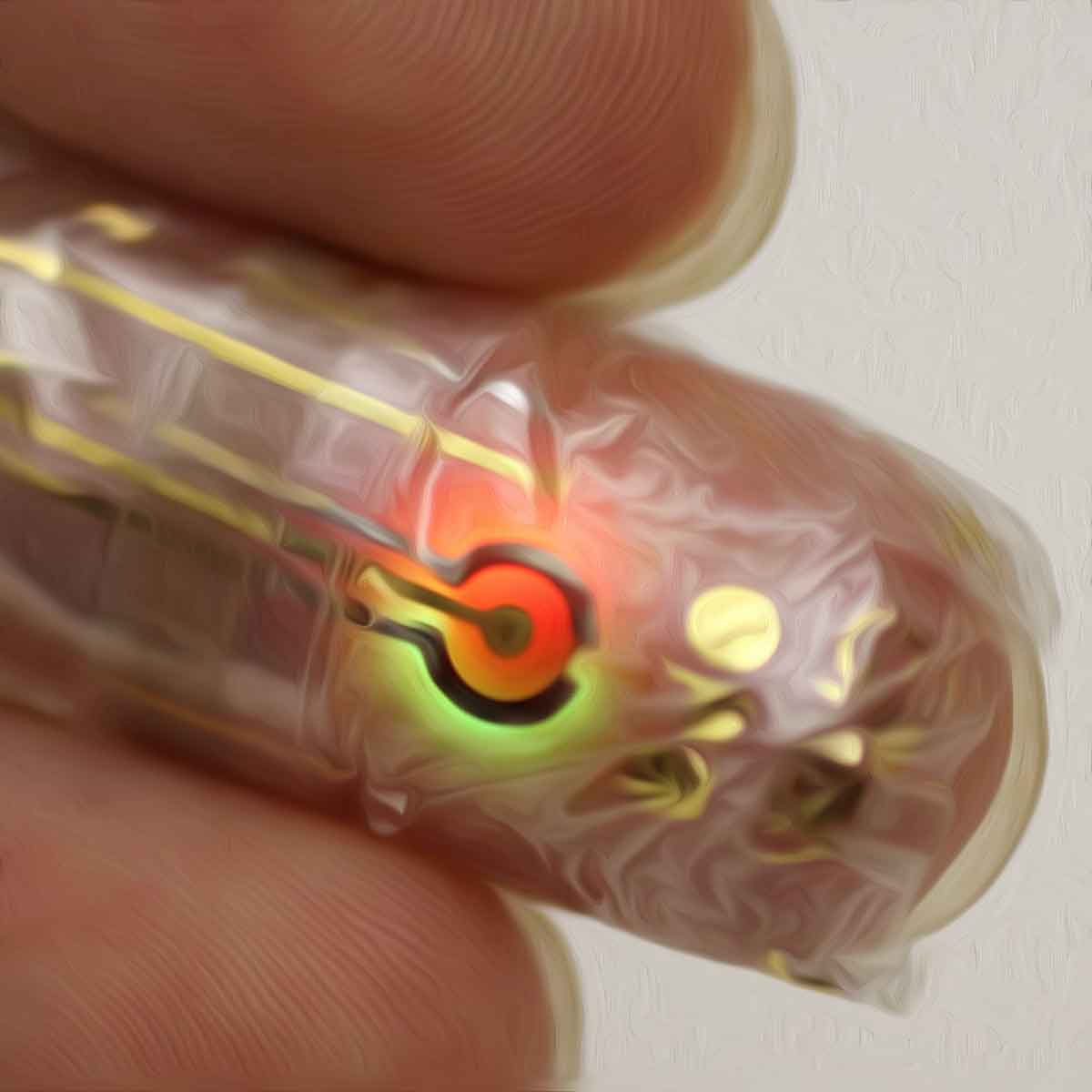MORE COVERAGE
Twitter Coverage
Satyaagrah
Written on
Satyaagrah
Written on
Satyaagrah
Written on
Satyaagrah
Written on
Satyaagrah
Written on
JOIN SATYAAGRAH SOCIAL MEDIA
Team of scientists led by Indian-origin engineer Ravinder Dahiya at University of Glasgow develops an 'Electronic skin' capable of feeling sensations like pain: could provide amputees, with prosthetics with feeling of touch that they lost

A team of engineers at the University of Glasgow in the UK led by India-born Ravinder Dahiya, Professor of Electronics and Nanoengineering at the James Watt School of Engineering, has developed an electronic skin that can feel sensations like pain.
A robot hand that uses the smart skin, has shown that it can ‘learn’ to react to external stimuli. This could help create a new generation of smart robots with near-human sensitivity
More importantly, it could provide amputees, with prosthetics -- artificial arms or legs -- with some semblance of the feeling of touch that they lost.
Prof Dahiya’s team shares details of their work in a paper: ‘Printed Synaptic Transistors based Electronic Skin for Robots to Feel and Learn’, published on June 1, in the journal Science Robotics.
|
The researchers describe how they built their prototype computational electronic skin (e-skin), and how it improves on the current state of the art in touch-sensitive robotics.
For decades, researchers have tried to create artificial (electronic) skin which possesses the sensation of touch. The widely used method was to spread an array of contact or pressure sensors across the electronic skin’s surface to allow it to detect when it comes into contact with an object. Data from the sensors is then sent to a computer to be processed and interpreted.
This can take a while: which is used to delay or degrade the electronic skin’s response to real-world tasks.
 |
E-skin that ‘learns’
The team in Glasgow, overcomes this handicap, by doing some of the processing in situ i.e., at the skin itself, avoiding too much to-and-fro traffic of the data.
In a communication to this reporter today, Prof Dahiya explained the nature of the breakthrough: “The distinctive part of our latest work is the e-skin’s capability to learn and perform some processing of tactile data, at the point of touch itself, instead of sending all raw data to the brain-equivalent on a robotic platform.”
In fact, it is how the human peripheral nervous system works -- and the Glasgow University team drew inspiration from this and mimicked the human system as best it could.
To build an electronic skin capable of quick response, the researchers printed a grid of 168 “synaptic” transistors made from zinc-oxide nanowires directly onto the surface of a flexible plastic surface. (Synaptic devices are those that have the ability to ‘learn’ in ways similar to nerve endings.) Then, they connected the synaptic transistor with the skin sensor present over the palm of a fully-articulated, human-shaped robot hand.
“We believe that this is a real step forward in our work towards creating large-scale neuromorphic printed electronic skin capable of responding appropriately to stimuli,” says Prof Dahiya, who did his M.Tech at IIT Delhi before he moved to the US for higher studies.
Adds Fengyuan Liu, co-author of the paper: “In the future, this research could be the basis for a more advanced electronic skin which enables robots capable of exploring and interacting with the world in new ways, or building prosthetic limbs which are capable of near-human levels of touch sensitivity.”
The recent work would help advances in both robotics and prosthetics, says the team.
 |
References:
 Support Us
Support Us
Satyagraha was born from the heart of our land, with an undying aim to unveil the true essence of Bharat. It seeks to illuminate the hidden tales of our valiant freedom fighters and the rich chronicles that haven't yet sung their complete melody in the mainstream.
While platforms like NDTV and 'The Wire' effortlessly garner funds under the banner of safeguarding democracy, we at Satyagraha walk a different path. Our strength and resonance come from you. In this journey to weave a stronger Bharat, every little contribution amplifies our voice. Let's come together, contribute as you can, and champion the true spirit of our nation.
 |  |  |
| ICICI Bank of Satyaagrah | Razorpay Bank of Satyaagrah | PayPal Bank of Satyaagrah - For International Payments |
If all above doesn't work, then try the LINK below:
Please share the article on other platforms
DISCLAIMER: The author is solely responsible for the views expressed in this article. The author carries the responsibility for citing and/or licensing of images utilized within the text. The website also frequently uses non-commercial images for representational purposes only in line with the article. We are not responsible for the authenticity of such images. If some images have a copyright issue, we request the person/entity to contact us at This email address is being protected from spambots. You need JavaScript enabled to view it. and we will take the necessary actions to resolve the issue.
Related Articles
- "Research is creating new knowledge, without which there is no progress": National Research Foundation - a visionary initiative by the Indian govt aimed at centralizing funding for scientific & academic research with an ambitious target of ₹50,000 crore
- Indian Govt banned 14 fixed-dose combination drugs including Nimesulide, Paracetamol dispersible tablets, Chlopheniramine Maleate and Codeine syrup citing there is "no therapeutic justification" for these medicines and that they may involve risk to people
- "Cyberspace undeniably reflects some form of geography": Ashwini Vaishnaw launched "Bharat 6G Alliance" for better collaboration between Govt, industry and academia in developing indigenous 6G products, India already has 200+ patents for 6G
- "Through turbulence and peace, the valley stands tall": Lal Chowk, Srinagar's heart, charts a tale from political fervor to darkness and now, resurgence. Decades of change, it's a testament to Kashmir's spirit and the valley's stride towards peace
- A grand leap in agricultural scenario - Upcoming Rice Technology Park in Kerala, is set to revolutionize the journey of Kuttanad rice from the verdant fields to the global stage with plans for value-added products, direct farmer procurement, and much more
- Mysterious death of Homi Bhabha and new trend started of top Indian scientists dying under mysterious circumstances
- "India's cosmic journey: From moonbeams to sunrays": ISRO's landmark Aditya-L1 mission set to launch, promising 24x7 Sun surveillance, aiming to decode solar mysteries, it will enhance our understanding of space weather and the profound Sun-Earth dynamics
- "We are not makers of history. We are made by history": Unveiling the Enigmatic Majesty - While the Sengol stole the limelight at inauguration, there is another astounding installation - Facoult's Pendulum dancing in Hallowed Halls of the new Parliament
- "Igniting India's resurgence: An epochal infrastructural odyssey": PM Modi inaugurates India's longest cable-stayed Sudarshan Setu, ignites a ₹4,150 crore development wave in Dwarka, embarks on a spiritual dive in Dwarka, blending heritage with progress
- "There is no law except the law that there is no law": Samudrayaan with Matsya 6000 is set to unlock the ocean's enigmatic heart, heralding a new era in harnessing marine resources for a sustainable future symbolizing a big leap in deep-sea exploration
- "Infinite eyes, a million words, a potpourri of vibes – Metro can never be boring": Breaking News - Union Govt approves 39 km Tricity metro rail corridor for Chandigarh, Mohali and Panchkula with an estimated cost of ₹10570 crore, was pending for 14 years
- “Moving mountains”: For 17 years, Dr. Madhavi Latha—India’s lone woman geotechnical warrior—fought rocks, storms, and silence to raise the Chenab Bridge, soaring 359m high, stitching Jammu to Srinagar and fulfilling a century-old dream with steel and soul
- "The growth and development of people is the highest calling of leadership": Modi Govt approved transforming New Delhi Railway Station into an architectural marvel and providing enhanced passenger experience with upgraded facilities
- In yet another milestone of BJP, Indian Railways First-Ever Freight Train Reaches ‘Rani Gaidinliu Railway Station’ marking a major breakthrough for railway authorities: Manipur
- "Trapping a Scientist": A Kerala cop maliciously framed ISRO scientist Nambi Narayanan in an espionage case after a Maldivian woman rejected his advances, leading to intense surveillance of innocents, and a Supreme Court-mandated Rs 50 lakh compensation

























